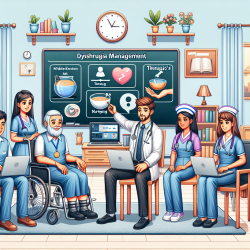Introduction
Burnout is a significant issue in the healthcare industry, affecting not only doctors and nurses but also speech-language pathologists (SLPs). The World Health Organization classifies burnout as an "occupational phenomenon," characterized by chronic workplace stress that has not been successfully managed. For SLPs, this can manifest as a sense of detachment from patients, depletion of emotional resources, and a diminished sense of personal fulfillment. However, the advent of Artificial Intelligence (AI) presents new opportunities to alleviate these challenges.
AI: A Potential Solution
The research article "Balancing act: the complex role of artificial intelligence in addressing burnout and healthcare workforce dynamics" highlights AI's potential to reduce the administrative and cognitive burdens that contribute to burnout. AI technologies, such as digital scribes, automated billing, and advanced data management systems, can streamline administrative tasks, allowing SLPs to focus more on patient care.
Streamlining Administrative Tasks
SLPs often spend a significant portion of their time on documentation and administrative tasks. AI-driven solutions, such as digital scribes, can help by automating the documentation process. These tools use speech recognition and natural language processing to transcribe and summarize patient interactions, reducing the time SLPs spend on paperwork and increasing the time available for direct patient care.
Enhancing Patient Care
AI can also enhance patient care by providing more accurate and timely information. For instance, AI-driven diagnostic tools can assist SLPs in assessing speech and language disorders more efficiently. By analyzing large datasets, AI can identify patterns and anomalies that may not be immediately apparent to human clinicians, leading to more accurate diagnoses and personalized treatment plans.
Challenges and Risks
While AI offers significant benefits, it also presents challenges. The potential for job displacement and the risk of diminishing clinical skills are notable concerns. As AI takes on more routine tasks, SLPs may find themselves dealing with more complex cases, which can increase stress levels. Additionally, over-reliance on AI could lead to a decline in critical thinking and problem-solving skills.
Mitigating Risks
To mitigate these risks, it is essential to prioritize AI technologies that align with stakeholder values and emphasize efforts to re-humanize medical practice. Continuous education and training programs can help SLPs adapt to new technologies while maintaining their clinical skills. Moreover, involving SLPs in the design and implementation of AI tools can ensure these technologies meet their needs and enhance their practice.
Conclusion
AI holds great promise for reducing burnout among speech-language pathologists by streamlining administrative tasks and enhancing patient care. However, it is crucial to approach AI integration thoughtfully, balancing its benefits with potential risks. By doing so, SLPs can harness AI's potential to improve their practice and well-being.
To read the original research paper, please follow this link: Balancing act: the complex role of artificial intelligence in addressing burnout and healthcare workforce dynamics.










